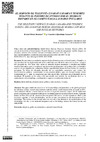Please use this identifier to cite or link to this item:
https://accedacris.ulpgc.es/handle/10553/107472
| Title: | El servicio de telefonía en Gran Canaria y Tenerife durante el periodo de entreguerras: modelos dispares en el camino hacia las redes insulares | Other Titles: | The telephony service in Gran Canaria and Tenerife during the interwar period: dissimilar models towards the insular networks | Authors: | Pérez Jiménez, R. Quintana Navarro, Francisco |
UNESCO Clasification: | 332501 Radiodifusión, sonido y televisión | Keywords: | Telefonía Canarias Redes insulares Network Canary Islands Public Administrations, et al |
Issue Date: | 2020 | Journal: | Anuario de Estudios Atlánticos | Abstract: | En este trabajo se estudia la respuesta de las administraciones de Gran Canaria y Tenerife a la
creciente demanda de implantación del servicio telefónico más allá de las redes urbanas hasta la llegada
del monopolio en 1924. Estas redes tenían un indudable impacto económico y cumplían una función
social cohesionadora, pero su despliegue suponía un reto presupuestario y de gestión, dados los limitados
recursos de que disponían las instituciones isleñas, especialmente durante la Gran Guerra y la inmediata
postguerra. La forma de afrontarlo dependía de las capacidades económicas que tuvieran las
administraciones públicas, convirtiéndolo en una prioridad política, pero esta decisión también estuvo
condicionada por el grado de compromiso que cada una de ellas mantuviera con el desarrollo de esta
tecnología. El aumento de las zonas a las que accedía este servicio fue un elemento clave en la
modernización del archipiélago, contribuyendo a mejorar su vertebración territorial. This paper studies the response of the Canary Islands administrations to the growing demand for telephone services beyond urban networks until the arrival / establishment of the monopoly in 1924. These networks fulfilled a social function and had an important economic impact, but its deployment posed a budgetary and managerial challenge for the limited capacities of administrative bodies, especially during the Great War and the immediate post-war period. The way to face this expenditure relied on the economic capacities of each administration, but also on their commitment to the development of this technology. The increase in the covered areas was not only a key element in the modernization of the Archipelago, but also on its territorial integration and on the linking between the Canary Islands and national life. |
ISSN: | 0570-4065 | DOI: | 10.36980/10587.10166 | Source: | Anuario de Estudios Atlánticos [ISSN 0570-4065], v. 2021 (67) |
| Appears in Collections: | Artículos |
Page view(s)
189
checked on Dec 14, 2024
Download(s)
168
checked on Dec 14, 2024
Google ScholarTM
Check
Altmetric
Share
Export metadata
Items in accedaCRIS are protected by copyright, with all rights reserved, unless otherwise indicated.
